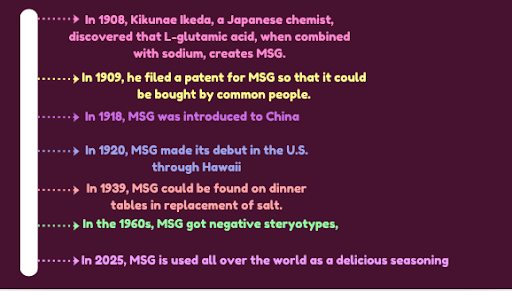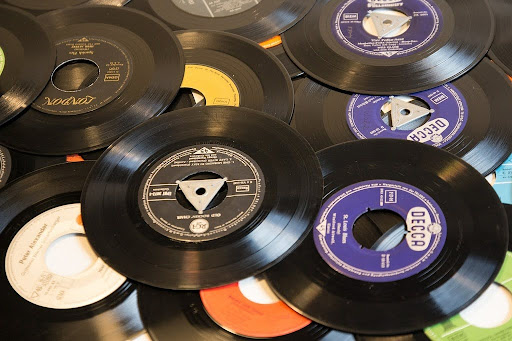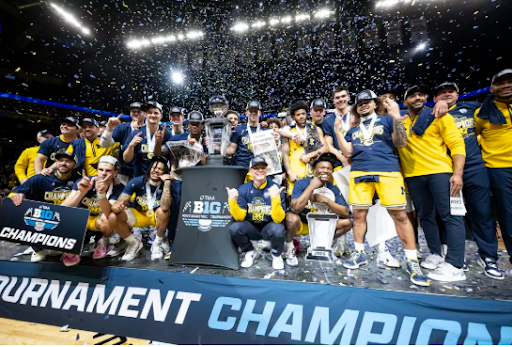Have you ever been to a restaurant and wondered how they make everything taste so delicious? If yes, then you have probably encountered Monosodium Glutamate (MSG). You probably don’t know what MSG is. Well, it is a substance that makes every food magically tasty. MSG is a flavor enhancer that you may not have heard of, but you unknowingly encounter it every day. You may find it in ramen soup, Doritos, and even some restaurant foods. It can also be found naturally in even more foods such as cheeses, tomatoes, and meat. Because it enhances flavor, many food sellers artificially add MSG to their food. We think that any food with MSG is really good. It can even be proven scientifically.
According to Food Insight, “The reason why MSG tastes so good can be broken down chemically: When MSG is eaten, the sodium and glutamate break apart in the saliva, and the free glutamate activates a person’s umami or savory taste receptors (umami was named after ‘umami,’ the Japanese word for ‘delicious’), creating that especially satisfying and savory flavor.” In this article, you’ll learn more about this salt-like seasoning, the common misconceptions surrounding it and how we think MSG, if eaten sparingly and safely, is not bad for your health.

The journey of MSG started many years ago with Kikunae Ikeda, a Japanese chemistry professor at the Imperial University of Tokyo, who stumbled upon the flavor enhancer. A legend said that he was drinking soup made by his wife and found it incredibly delicious. He was inspired by the bowl of soup to set out on a scientific journey to find the magic substance that made it so good, he found that before his wife made the soup, she would put a piece of kelp into boiling water and create the amazing and delicious soup. After discovering this, he started studying and experimenting with the chemical structure of kelp. Eventually, in 1908, he discovered that the deep savory taste that the kelp had was caused by a substance called L-glutamic acid (glutamate) combined with sodium. According to Food Insight, “When glutamate was combined with sodium, the substance became known as MSG.” In 1909, he filed a patent to produce MSG so common people could buy it.
MSG was initially marketed towards the upper class and used for home cooking, but it soon became much more widespread; by 1939, MSG could be found on dinner tables in replacement of salt. Because of its common use in households, MSG soon became a widely used ingredient in restaurants.
But it didn’t stop there. In Taiwan, street vendors were taking a very different approach. In their world of business, the only thing that mattered was flavor. Street vendors embraced MSG and adapted easily to the new ingredients. In addition to its new widespread popularity, around 1918, MSG also ended up in China, being marketed as a new modern lifestyle. Though it initially faced some pushback, it was eventually accepted and incorporated into Chinese food.
At last, in 1920, MSG finally made its debut in the U.S. through Hawaii, likely because of requests coming from a large number of Japanese immigrants working on the islands’ sugar plantations.
However, MSG has raised concerns over the years when people reported that they got negative side effects from eating it. The negative stereotype was widely shared in the 1960s when a physician stated that he got sick after eating at a Chinese restaurant. He said that either alcohol, sodium, or MSG could’ve caused this sickness. In our opinion this MSG, we think that MSG didn’t cause these symptoms. Alcohol is really bad, and too much sodium is also really bad. We probably eat a lot of MSG every day (foods from restaurants and natural foods like tomatoes, etc.), and we don’t get sick from eating it. So we think MSG probably didn’t cause it.
To express his anger, the physician wrote a letter to The New England Journal of Medicine about his unexpected illness, “His story sparked an outrage against MSG. As a result, hypersensitivity to MSG wrongly became known as ‘Chinese Restaurant Syndrome’ which is now more properly referred to as ‘MSG symptom complex,’” said Food Insight. Because of this, many Asian restaurants observed a drop in sales due to health concerns.
But in the modern day, some people, believe that MSG might actually be healthy for you, according to Food Insight, “Both salt and MSG add flavor, but MSG contains about three times less sodium than the same amount of table salt, so using MSG instead of table salt can help reduce sodium intake. Many people are advised to limit their sodium intake due to the connection between excess sodium intake and various diet-related chronic diseases, such as high blood pressure — MSG can be used as a tool to reduce sodium without compromising flavor.”
This explanation shows that MSG could actually help people cope with health problems by providing a low-sodium alternative to salt. Some of these health problems that require a lower sodium intake include high blood pressure, kidney disease, and heart issues. But like any food, too much MSG is not good for you. It can lead to headaches, difficulty breathing, weakness, flushing, dizziness, muscle tightness, numbness, and fainting. In our opinion, too much MSG is not good for your health as well as too much vitamins, carbohydrates, and medicine like Advil and Tylenol.
In addition to the reassurance coming from Food Insight, the FDA permits MSG to be added to foods, “The FDA considers the addition of MSG to foods to be ‘generally recognized as safe’ (GRAS). Although many people identify themselves as sensitive to MSG, in studies with such individuals given MSG or a placebo, scientists have not been able to consistently trigger reactions,” the FDA said. This is backed up by a quote from Harvard Health, stating that “The FASEB concluded that MSG is safe. They noted that any ill effects were mild and short-lived, and were typically associated with large doses (more than three grams) of MSG that were consumed without food.”
Today, MSG is a seasoning used in various foods, and it is enjoyed all over the world. Many well-known foods, such as ramen, take-out foods, and more, include MSG. Some people use MSG as a substitute for salt because it has less sodium than salt. Overall, MSG, though clouded in worry about the effects it may have on your health, is enjoyed all over the world as a delicious seasoning and is fairly safe to eat as long as you use it sparingly and safely. We think MSG is okay for your health and maybe even good if you eat it sparingly and safely.
Sadly, even today, about half of the people in the Clague community are misinformed on the effects of MSG, as shown below 54.5% of Clague students do not know what MSG is, the study also revealed that 45.5% of people taking the survey believed that MSG was hurting their health (45.5% said they did not think MSG was hurting them, and 9.1% did not know what MSG was). When asked what they knew about MSG, people’s answers varied quite a bit; the responses ranged from. For example, someone said: “MSG is a flavor enhancer that’s frequently added to canned vegetables, soups, deli meats, and restaurant foods to lend a savory, rich flavor.”


This shows how many people have very different experiences with MSG and that misinformation about MSG is still spreading. We think that almost all people should know what MSG is. So this article will help those people that don’t know what MSG is.
From tomatoes to fast food, MSG is something we unconsciously encounter almost daily. This is why we think it is important for everyone to be properly informed about what MSG does and how it can be used safely and make your food taste better everyday.













